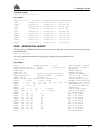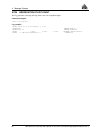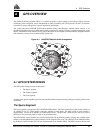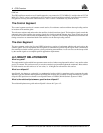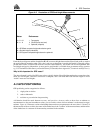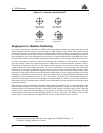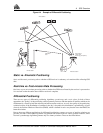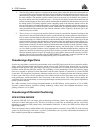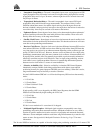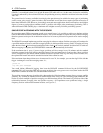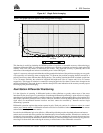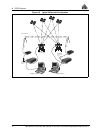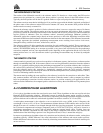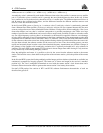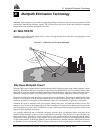
A GPS Overview
MiLLennium GPSCard SW Version 4.503/4.52 Command Descriptions Manual Rev 2 69
• Ionospheric Group Delays – The earth’s ionospheric layers cause varying degrees of GPS
signal propagation delay. Ionization levels tend to be highest during daylight hours causing
propagation delay errors of up to 30 meters, whereas night time levels are much lower and
may be up to 6 meters.
• Tropospheric Refraction Delays – The earth’s tropospheric layer causes GPS signal
propagation delays which bias the range measurements. The amount of delay is at the
minimum (about three metres) for satellite signals arriving from 90 degrees above the
horizon (overhead), and progressively increases as the angle above the horizon is reduced to
zero where delay errors may be as much as 50 metres at the horizon.
• Ephemeris Errors – Some degree of error always exists between the broadcast ephemeris’
predicted satellite position and the actual orbit position of the satellites. These errors will
directly affect the accuracy of the range measurement.
• Satellite Clock Errors – Some degree of error also exists between the actual satellite clock
time and the clock time predicted by the broadcast data. This broadcast time error will cause
some bias to the pseudorange measurements.
• Receiver Clock Errors – Receiver clock error is the time difference between GPS receiver
time and true GPS time. All GPS receivers have differing clock offsets from GPS time that
vary from receiver to receiver by an unknown amount depending on the oscillator type and
quality (TCXO VS. OCXO, etc.). However, because a receiver makes all of its single point
pseudorange measurements using the same common clock oscillator, all measurements will
be equally offset, and this offset can generally be modeled or quite accurately estimated to
effectively cancel the receiver clock offset bias. Thus, in single point positioning, receiver
clock offset is not a significant problem. However, in pseudorange differential operation,
between-receiver clock offset is a source of uncorrelated bias.
• Selective Availability (SA) – Selective availability is when the GPS Control Segment
intentionally corrupts satellite clock timing and broadcast orbit data to cause reduced
positioning accuracy for general purpose GPS SPS users (non-military). When SA is active,
range measurements may be biased by as much as 30 metres.
NovAtel’s MiLLennium GPSCard is a civilian dual-frequency GPS receiver that normally
tracks:
• L1 C/A Code
• L1 Carrier Phase
• L2 Semi-Codeless P Code
• L2 Carrier Phase
If anti-spoofing (AS) is ever dropped by the GPS Control Segment, then the OEM4
GPSCard will automatically begin tracking the L2 P Code:
• L1 C/A Code
• L1 Carrier Phase
• L2 P Code
• L2 Carrier Phase
P Code is never tracked on L1 even when AS is dropped.
• Multipath Signal Reception – Multipath signal reception can potentially cause large
pseudorange and carrier phase measurement biases. Multipath conditions are very much a
function of specific antenna site location versus local geography and man-made structural
influences. Severe multipath conditions could skew range measurements by as much as 100
meters or more. See Appendix B, Multipath Elimination Technology, Page 75 for more
information.
The NovAtel GPSCard receivers are capable of absolute single point positioning accuracies of 15 meters CEP



